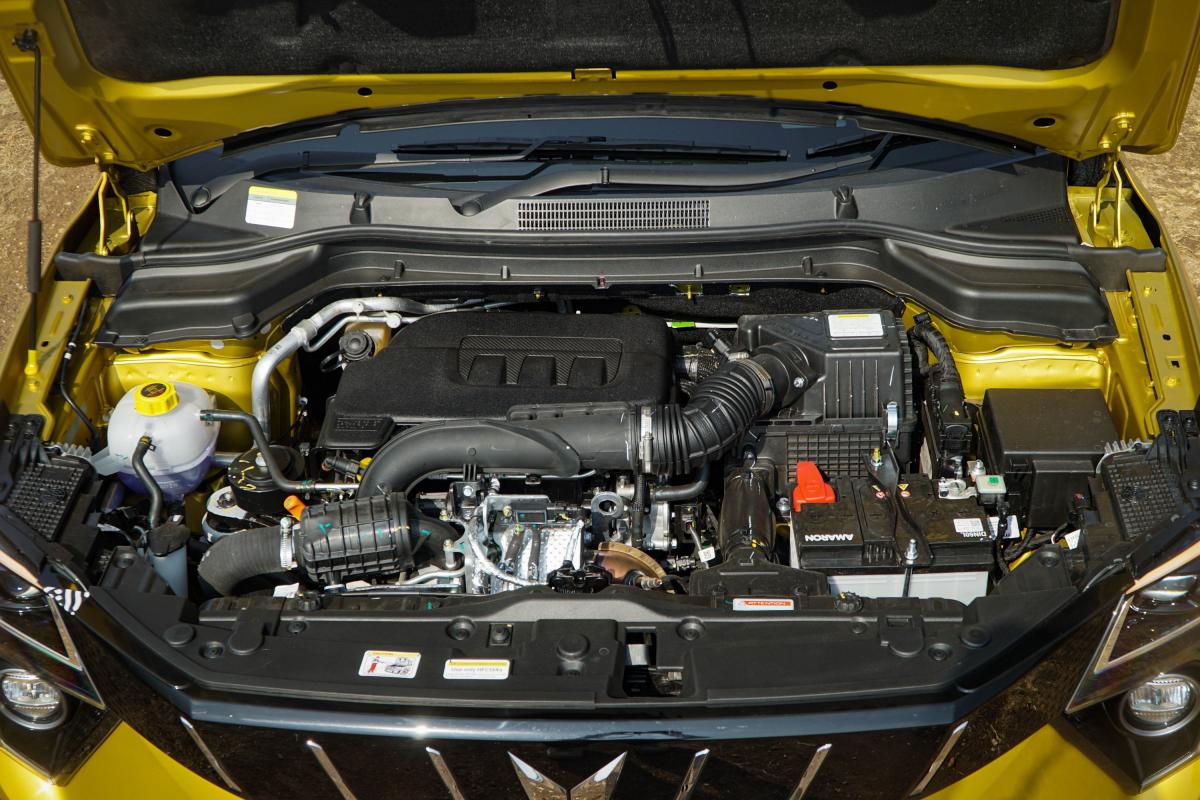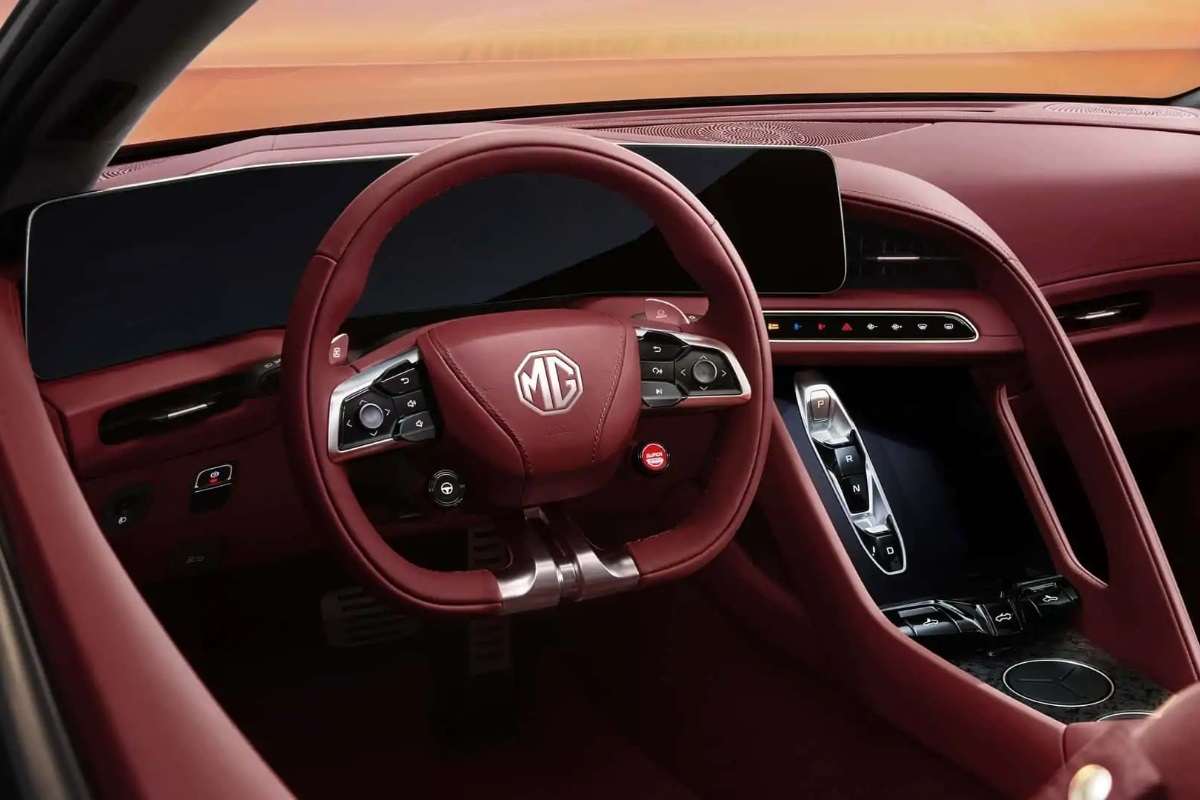This 1.2-litre turbo-petrol GDi engine is a very likeable motor and packs a serious punch.
Driving the Mahindra XUV 3XO 1.2L Turbo-Petrol GDi 6-speed AT
1.2-litre turbo-petrol engine with gasoline direct injection (GDi) produces 129 BHP @ 5,000 rpm and 230 Nm @ 1,500-3,750 rpm. It is mated to a 6-speed automatic transmission:

Mahindra introduced the 1.2-litre turbo-petrol GDi engine back in 2022 with the XUV300 TurboSport Series. The engine was available only with a 6-speed MT and was pitted as a performance variant which, in a way, it was. It was the fastest turbo-petrol car in its segment, but it didn’t have a proper automatic gearbox. With the XUV 3XO, Mahindra has rectified that by offering the 3rd-generation 6-speed Aisin-sourced automatic transmission for its turbo-petrol engines.
The 3-cylinder turbo-petrol engine is an all-aluminium unit which has the exhaust manifold integrated into the cylinder head. The GDI system has an injection pressure of up to 250 bar and the engine also has an over-boost function that gives it a momentary peak torque of 250 Nm.
Driving the XUV 3XO petrol AT is a smooth experience. This 1.2-litre turbo-petrol GDi engine is a very likeable motor and packs a serious punch. Direct comparisons will be drawn to the 109 BHP turbo-petrol MPFI engine and the GDi unit is more linear with its power delivery and also packs more punch. The petrol engine with the 6-speed AT is smooth and city-friendly. Off the line, the throttle response is linear and at low speeds, the turbo lag is masked well by the automatic transmission. The driveability at low speeds is good and you’ll appreciate it even more while driving in bumper-to-bumper traffic. With a light foot on the accelerator, you can navigate through city traffic effortlessly without any unnecessary spikes in power delivery. We’d recommend being in the Zip (Eco) mode for a smoother driving experience. As mentioned earlier, the turbo-petrol packs a punch and has a strong mid-range. Power comes in strong at just above 1,500 rpm and you can make those quick overtakes in the city.
Out on the open road is where you can flex your right leg for the XUV 3XO to stretch its legs. With 129 BHP on tap, you will reach the 100 or 120 km/h mark without even realising it. There’s enough power available for overtaking with ease and covering good ground quickly. The engine’s marked redline is 5,500 rpm which is low, but something that’s not uncommon with turbo-petrols. This is not a high-revving engine and in kickdown mode, you will see the shifts happening at ~5,000 rpm. The engine is also relaxed when cruising at highway speeds and you will see it spin at 1,900 rpm at 100 km/h and 2,200 rpm at 120 km/h in the 6th gear.
As we have seen in the past with Aisin gearboxes, the 6-speed torque converter unit in the XUV 3XO is also butter-smooth in its operation. The shifts are barely noticeable while driving in the city with a light foot. You’ll have to pay attention to the change in engine noise to pinpoint when the shifts happen. This isn’t a fast-shifting gearbox, but it’s not slow either. Response times are acceptable for day-to-day driving and even when driving spiritedly, the gearbox manages to keep up well. In certain situations, when driving hard, you might feel that the gearbox is getting confused, but those instances are few. The gearbox does a satisfactory job for the most part. In the city, the gearbox feels eager to drop down gears when off the throttle to make sure that the rpm doesn’t drop too low and the engine stays in the power band. There’s a manual mode, but it’s not very intuitive and most owners would prefer letting the electronics do the shifting for them. Unfortunately, there are no paddle shifters which some enthusiasts would love to have.
Like some of the other Mahindra cars, you have 3 driving modes called as Zip, Zap and Zoom (hilarious name selection)-
Zip Mode: This is essentially the Eco driving mode in which throttle response is dulled. You can use this mode while driving in the city as it makes the experience smoother. On the highway, you can use this mode for cruising and some overtakes as well. But if you want to overtake quickly, you’ll be better off switching to other modes.
Zap Mode: This is the Normal mode. It strikes a perfect balance between the other two modes and you can use it for your daily driving in the city as well as on the highways.
Zoom Mode: When you’re in the mood for some spirited driving, you should switch to this Zoom mode. Throttle response is the sharpest in this mode and the car feels very eager to your inputs. The steering weighs up in this mode, but not as much as enthusiasts would prefer. Using this mode in the city isn’t advisable as the driving experience is too jerky.
Noise, Vibration & Harshness (NVH)
Mahindra has added panel damping to improve the NVH. They claim that with the improvements in the NVH package, the XUV 3XO’s cabin will be as quiet as the XUV700’s cabin. The engine is quiet at idle and you don’t feel any vibrations in the cabin. On the move, the wind noise is well controlled. Road noise starts to creep into the cabin at 100 km/h. The audio system comes with a feature called as VNC++ that automatically adjusts the loudness to maintain tonal balance against the road noise.
Mileage & Fuel Economy
The Mahindra XUV 3XO comes equipped with Zip driving mode (Eco) and also an idling start / stop system that helps improve fuel efficiency. The claimed fuel economy of the 1.2-litre turbo-petrol GDi engine with the 6-speed MT and 6-speed AT is 20.1 km/l and 18.2 km/l, respectively. The other turbo-petrol engine with 109 BHP (MPFI) has a claimed fuel economy of 18.89 km/l with MT and 17.96 with AT. The 1.5-litre diesel engine has a fuel economy of 20.6 km/l with the MT and 21.2 km/l with the AMT.
Suspension

Ride Comfort
The XUV 3XO uses an independent MacPherson strut suspension at the front and a semi-independent twist beam suspension at the rear. There are some changes compared to the XUV300. You get a rebound stopper in the top strut mount to reduce the impact forces. At the rear, the span between the springs is the highest in the segment (1,108 mm) which improves the roll stability. Importantly, the dampers now get Mahindra’s MTV-CL technology which stands for Multi-Tune Valve with Concentric Land. Essentially, it fine tunes the damping force by controlling the fluid through piston valves.
At low speeds, the ride quality is compliant and mature. There is an underlying stiffness to the ride, but it’s not uncomfortable by any means. The 17-inch rims add to this. Small bumps are absorbed well and the suspension does its work quietly. Larger potholes do register themselves in the cabin sharply. Like most Mahindra cars, the setup also feels rugged and abuse-friendly. You can manage to get away with carrying some extra speed over a rough patch or a speed breaker. Overall the ride is compliant and most owners will be happy with the XUV 3XO’s suspension setup.
Handling & Dynamics
A unique aspect of the XUV 3XO is its footprint. It has a long wheelbase and the front & rear tracks are wide too. This gives the XUV 3XO a very stable stance and that is very much evident in the handling of the car. At highway speeds, the ride improves and the car is stable with very little vertical movement. Expansion joints and minor undulations do not make it unstable and passengers are comfortable even in the rear seat.
Get into the twisty bits and you will appreciate the handling characteristics of this chassis. The car remains composed in slow and fast corners. Even changing directions from one corner to another is a smooth affair and you won’t have any scary surprises. The handling is very predictable and you can carry a good amount of speed into corners without feeling nervous. The 215/55 Goodyear Assurance tyres on our test car provided a good grip.
Steering
The Mahindra XUV 3XO’s steering is one of the biggest drawbacks in an otherwise capable dynamics package. It was a weak link with the pre-facelift car and it remains the same on this one. The steering is too vague for any kind of feedback and feels dead in the centre. It almost feels like an arcade steering. It weighs up as you gain speed and in Zoom mode, but it still isn’t enough. When pushing the car on twisty roads, you will want more feedback when turning into a corner. On the flip side, the steering is very light and easy to use in the city and while parking.
Braking
All variants of the XUV300 come with all-wheel disc brakes, ABS + EBD. Mahindra has also added the same ESP tech (ESP 9.3) from the XUV700 in the XUV 3XO. Emergency braking manoeuvres are handled well by the car and it comes to a stop without any drama. They perform well in day-to-day driving conditions. That being said, the bite is quite sharp. We would’ve liked the pedal to be a little more progressive.
Continue reading the discussion on the Mahindra XUV 3XO on our forum.







